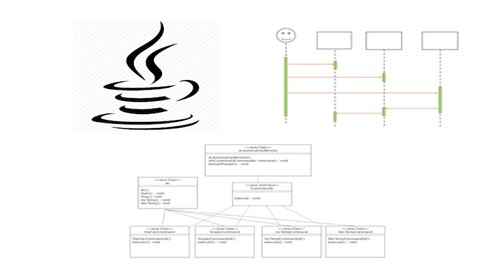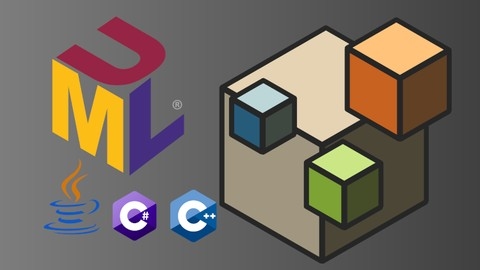Object-Oriented Design (OOD) is a cornerstone of modern software development, providing a structured approach to building robust, maintainable, and scalable applications.
By understanding OOD principles, you can create modular code that is easier to understand, modify, and extend, leading to more efficient development cycles and higher-quality software.
Learning OOD unlocks the ability to design complex systems with clarity and precision, making you a more valuable asset in any software development team.
Finding a comprehensive and effective Object-Oriented Design course on Udemy can be overwhelming, considering the sheer number of options available.
You’re searching for a course that not only covers the theoretical foundations but also provides practical examples and hands-on exercises to solidify your understanding.
You want a course that equips you with the skills to design and implement real-world applications using object-oriented principles.
After reviewing numerous courses, we’ve found that the best course overall for mastering Object-Oriented Design on Udemy is Master Object Oriented Design in Java - Homework + Solutions.
This course stands out for its in-depth coverage of OOD principles, its practical exercises and homework assignments, and the inclusion of solutions to reinforce your learning.
It’s an excellent choice for those who want to gain a deep understanding of OOD and apply it effectively in Java programming.
While this is our top recommendation, there are other excellent courses on Udemy that cater to different learning styles and focus areas.
So keep reading to explore our curated list of the best Object-Oriented Design courses on Udemy, each designed to help you master this essential skill and elevate your software development capabilities.
Master Object Oriented Design in Java - Homework + Solutions
You’ll begin by exploring the fundamental concepts of classes and objects, learning how they interact and how to build applications using them.
The course then delves into the inner workings of Java, explaining how the language functions behind the scenes.
You’ll gain a deep understanding of the relationship between classes, objects, and the runtime environment, which will give you a solid foundation for building complex applications.
The course doesn’t stop at the basics.
You’ll then dive into the SOLID principles, which are essential for creating maintainable and flexible code.
You’ll learn how to apply these principles through hands-on exercises and real-world examples.
For example, you’ll learn about the Single Responsibility Principle by applying it to a specific coding challenge, and you’ll visualize the application of the Liskov Substitution Principle using UML diagrams.
This course goes beyond theory, teaching you how to apply these concepts to real-world scenarios.
You’ll learn about popular design patterns such as the Observer Pattern, the Builder Pattern, and the Factory Pattern.
The course also covers advanced techniques like Dependency Injection, a powerful technique for creating loosely coupled and maintainable code.
You’ll learn how to use Dependency Injection with popular frameworks like Spring, which is essential for building modern Java applications.
You’ll understand how to apply object-oriented design principles and patterns to solve real-world problems, and you’ll be prepared for a successful career in software development.
SOLID Principles of Object Oriented Design and Architecture
This course takes a methodical approach to teaching you the core principles of SOLID, guiding you from the historical context to real-world application.
You’ll learn about the origins of the Single Responsibility Principle, and see how it is demonstrated in the Employee, AuthManager, and KaraokePlayer examples.
You’ll be introduced to Abstractions as a fundamental concept in object-oriented design, exploring how they contribute to code flexibility and reusability.
The course delves into each of the five principles with detailed explanations and concrete examples.
You’ll see how to implement the Open Closed Principle through the Salary Calculator and Karaoke Application examples.
You’ll gain a practical understanding of the Liskov Substitution Principle by examining its application to the Rectangle and Square example.
Furthermore, you’ll discover the importance of the Interface Segregation Principle through examples like the Publish-Subscribe architectural pattern and the use of Callbacks.
You’ll be guided through the Dependency Inversion Principle and its use in decoupling code with practical examples.
The course utilizes UML diagrams to visually demonstrate these concepts, providing a clear and accessible way to understand the relationships between different parts of your code.
You’ll gain an in-depth understanding of how these principles relate to each other and how they can be applied effectively in your own projects.
Java Object Oriented Programming:OOPS OOAD & Design Patterns
This course is a comprehensive exploration of Object-Oriented Programming (OOP), offering a solid foundation in both core concepts and advanced design patterns.
You’ll begin by delving into the core principles of OOP: encapsulation, inheritance, polymorphism, and abstraction.
These fundamental concepts are the building blocks of efficient and maintainable code.
You’ll learn how to use classes, objects, and methods to structure your programs effectively.
The course then moves on to explore various design principles that help you craft clean, readable, and adaptable code.
You’ll learn about SOLID principles, like the Single Responsibility Principle and the Open-Closed Principle, and explore other valuable principles like DRY (Don’t Repeat Yourself) and KISS (Keep It Simple, Stupid).
These principles are essential for creating code that is easy to understand, modify, and extend.
Next, you’ll delve into the world of Design Patterns.
These pre-defined solutions to common programming challenges will help you write more elegant and reusable code.
You’ll learn about various design patterns, including creational, structural, and behavioral patterns, such as the Singleton, Factory, Adapter, Decorator, and Observer patterns.
These patterns can significantly enhance your code’s flexibility and maintainability.
The course concludes with a focus on best practices for efficient and maintainable code.
You’ll explore key concepts like technical debt, high cohesion, loose coupling, and the importance of writing effective comments.
Object Oriented Analysis, Design & Programming with UML
You’ll dive into the fundamentals of Object-Oriented Programming (OOP) with a strong emphasis on the Unified Modeling Language (UML).
Right from the start, you’ll learn how to model real-world problems using UML diagrams.
You’ll explore Use Case diagrams to map out user interactions, Class diagrams to define your software’s structure, and Sequence diagrams to visualize interactions between objects.
You’ll gain hands-on experience implementing these designs using popular programming languages like Java, C#, and C++.
The course goes beyond the basics, guiding you through essential OOP concepts like abstraction, encapsulation, inheritance, and polymorphism.
You’ll learn to apply these concepts to create robust software solutions, like building a fully functional game environment complete with player characters, game objects, and collision detection.
The course emphasizes practical application, incorporating interactive exercises and projects that allow you to solidify your understanding and build confidence in your OOP skills.
You’ll learn how to effectively utilize UML for real-world projects, making you a valuable asset in any development team.
Object Oriented Programming and Design Crash Course
You’ll start by understanding the fundamentals of objects and classes, exploring their states and responsibilities.
The course emphasizes the Single Responsibility Principle, which will help you write code that is both robust and easily maintainable.
You’ll dive into powerful techniques like composition, which lets you combine objects to build complex systems.
You’ll also learn about dependency injection, a crucial practice for writing flexible and reusable code.
The course covers inheritance, another fundamental OOP concept, and explores its differences in statically and dynamically typed languages.
You’ll learn how to leverage inheritance to promote code reuse effectively.
Moving beyond the fundamentals, the course delves into the principles of object-oriented design.
You’ll learn to model real-world objects, understand abstractions, and apply proper naming conventions.
The course introduces important design patterns, such as Observer, Facade, Strategy, and Singleton.
These patterns provide tried-and-true solutions to common programming challenges, helping you write more elegant and efficient code.
Test Driven Object Oriented Design - SOLID, Patterns & LLD
You’re looking for a course that will teach you how to design object-oriented applications effectively, and this one certainly has a lot to offer.
It focuses on the SOLID principles, a set of guidelines for writing flexible, maintainable, and reusable code, and dives into common design patterns that provide proven solutions to common software development challenges.
The course takes a practical approach, using real-world examples like building a banking application and a shopping cart.
You’ll learn by doing, applying the SOLID principles and design patterns directly to these projects.
For example, you’ll see how the Single Responsibility Principle is used to create modular and manageable code in the banking application.
You’ll also learn how the Strategy Pattern can be used to switch between different pricing strategies for the shopping cart, adding flexibility to your application.
While the course covers a wide range of essential topics, you’ll also benefit from its focus on practical implementation.
You won’t just be reading about the SOLID principles and design patterns—you’ll be putting them into practice, building real applications that demonstrate their effectiveness.
UML and Object-Oriented Design Foundations
This course provides a comprehensive foundation in object-oriented design, focusing on the use of the Unified Modeling Language (UML).
You’ll gain a solid understanding of how UML diagrams can help visualize and design complex software systems.
The course starts with a valuable exploration of software development methodologies, comparing the Waterfall and Agile approaches.
This comparative analysis helps you understand the strengths and weaknesses of each methodology and consider which best suits your project needs.
The core concepts of object-oriented programming, such as objects, classes, abstraction, encapsulation, inheritance, and polymorphism, are explained clearly.
You’ll develop a strong grasp of these fundamental concepts and how they contribute to the structure and functionality of object-oriented systems.
Moving beyond theory, the course delves into object-oriented analysis and design.
You’ll learn to use UML to model your systems, creating various diagrams including use case, class, sequence, activity, and statechart diagrams.
This hands-on approach allows you to apply your understanding to real-world scenarios.
The course also includes a practical case study where you design a note-taking app from scratch.
This experience solidifies your understanding of object-oriented design principles by walking you through the entire design process.
You’ll collect requirements, map them to user stories, create UML diagrams, and model state transitions.
This practical approach is a significant advantage as it provides a concrete example of how the concepts you learn can be applied in real-world projects.
SOLID Principles: Object-Oriented Design & Architecture
This course delves into the five SOLID principles, which are crucial for crafting high-quality object-oriented software.
You’ll learn how to apply these principles to create systems that are flexible, easy to maintain, and robust.
The course begins with the Single Responsibility Principle.
You’ll explore real-world examples, such as refactoring a codebase that manages both user accounts and email notifications.
You’ll learn to identify and eliminate scenarios where a single class attempts to handle too many responsibilities, leading to confusion and maintenance headaches.
You’ll also be introduced to the use of UML diagrams, which help visualize the relationships between classes and identify potential problems.
Moving on, you’ll delve into the Open/Closed Principle.
This principle emphasizes the ability to extend functionality without modifying existing code.
The course uses practical examples to illustrate how this principle can prevent bugs and maintain stability, while enabling you to quickly add new features without breaking existing code.
You’ll learn how to leverage abstract classes and interfaces to create designs that are open for extension but closed for modification.
Next, the course covers the Liskov Substitution Principle.
This principle ensures that subtypes can be seamlessly substituted for their base types without introducing errors.
You’ll explore how this principle is essential for maintaining the integrity of polymorphism, and how to avoid common pitfalls by understanding preconditions and postconditions of methods.
Then, you’ll learn about the Interface Segregation Principle.
This principle advocates breaking large interfaces into smaller, more specific ones.
You’ll see how this can reduce dependencies, enhance code clarity, and lead to more maintainable software.
The course uses examples like a customer management system to demonstrate how applying this principle can result in a more modular and flexible design.
Finally, you’ll be introduced to the Dependency Inversion Principle.
This principle emphasizes loose coupling between software components.
The course explains how dependency injection plays a crucial role in achieving this, and provides a step-by-step guide on implementing this technique.
You’ll learn how to inject dependencies effectively, leading to a system that is more flexible and easier to test.








